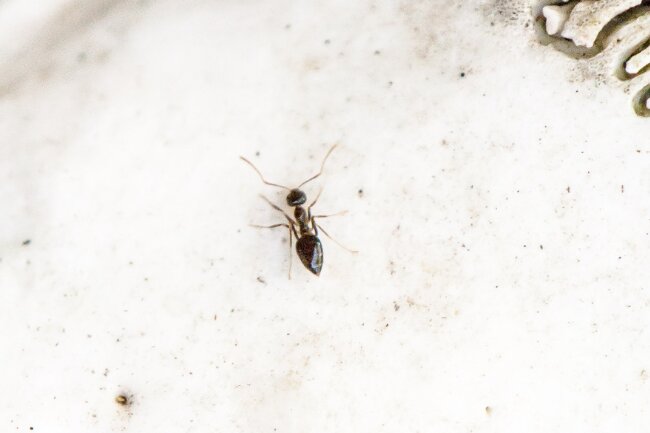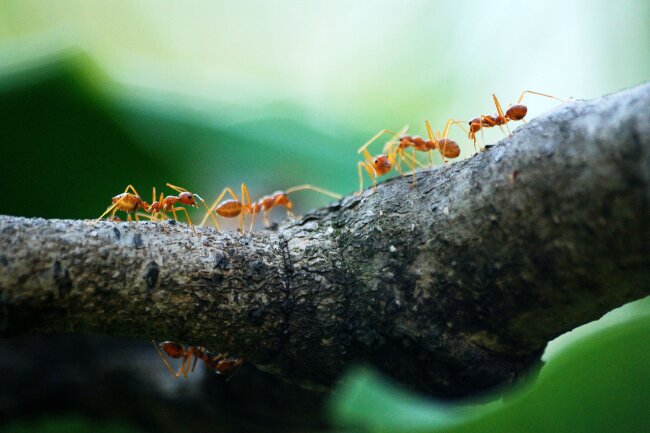Ants use lots of different methods to survive the winter, from huddling together in their nests to entering a kind of winter slumber. Their mixture of learned adaptions and evolutionary advantages means that, unlike some insects, they do not die out in the winter.
Contents
Do ants die in the winter?

When it comes to insects that live in colonies we tend to think of them dying off during the winter, such as many bee and wasp species, yet ants have cleverly found a way to survive the winter cold as a community, without needing to lose many of their numbers.
| Species | Survival Strategy |
|---|---|
| Carpenter Ants | Seek shelter in protected areas such as logs or tree trunks. |
| Argentine Ants | Form supercolonies to increase chances of survival. |
| Harvester Ants | Store large amounts of seeds as winter food reserves. |
| Red Imported Fire Ants | Create mounds with complex tunnel systems for temperature regulation. |
| Allegheny Mound Ants | Construct large mounds that trap heat during the winter months. |
Like most insects, ants do need warmth to survive, and winter temperatures in many countries would be enough to kill them if they hadn’t found clever techniques to keep themselves warm during these tough times.
Also read: Do Ladybugs Die in the Winter? Do they Hibernate?
Winter-free
There are around 13,000 ant species across the world, and they are found on every continent apart from Antarctica. Across these continents they have adapted to every kind of environment, from rainforests to deserts, to open prairies. This means that not all ant species have to survive winter, as they don’t experience it.
| Strategy | Description |
|---|---|
| Hibernation | Some ant species enter a state of hibernation, reducing their activity and metabolic rate to conserve energy. |
| Nest Depth | Ants may move deeper into their nests to reach warmer soil layers and protect themselves from freezing temperatures. |
| Colony Size | Larger ant colonies have a better chance of survival as they can generate more heat collectively and share resources. |
| Food Storage | Ants gather and store food during the warmer months to sustain the colony during winter when food sources are scarce. |
| Antifreeze Agents | Certain ant species produce antifreeze agents or chemicals that lower the freezing point of their bodily fluids. |
| Nest Insulation | Ants may use insulating materials like plant matter, soil, or debris to cover their nest entrances and regulate temperature. |
| Thermal Cycling | Some ant species perform short foraging trips during warmer winter days to collect food and maintain their energy levels. |
Ants in tropical regions may still have many seasonal hardships to overcome, but freezing temperatures are generally not part of the problem. Their counterparts in colder regions do have to think of how to keep themselves warm as the days become darker and shorter, however.
Feast and famine

We may not think of ants as piling on the pounds, but these tiny creatures are known for fattening themselves up for the winter. Throughout the spring and summer ants will eat more indiscriminately but in the autumn they have been found to try and eat a carbohydrate-rich diet, so they can store these carbs to get through the winter.
Some ant species will also store food for the winter, such as Messor aciculatus who have been found to carry in grain into the nest to see them through the tougher winter season. Some species will also fatten up the younger members of the nest, to better protect them from the harsher winter, whereas the more experienced members may forage on days when the temperature rises.
Diapause
Diapause is the insect equivalent of hibernation. During diapause insects are sluggish and less responsive, their metabolic rate slows, and they do not feed, grow or reproduce. This helps them to get through a time when there is less food available. This is the key way that ants get through the winter, simply by sleeping through it.
Also read: Do Ants Sleep? How, When, Where… Explained
Huddling

Ants may not seem like cuddly creatures, but huddling together to keep warm is a key survival tactic during the winter months. Often, ants will move to a deeper part of the nest, where the heat of the surrounding soil will keep them insulated and warm. By gathering together, they are able to keep themselves warmer throughout the winter months.
Sticks and stones
As well as using internal heat, ants have a clever trick of harvesting heat from inanimate objects. For example, ants may choose to build their nest under rotting leaves or bark, or beneath stones. Rotting plant matter gives off warmth, providing heat to the ant colony. Stones will warm in the sun and then radiate that heat out when the air temperature falls.
Some ant species farm fungus within their colonies and this fungus itself can produce heat that they can benefit from.
Nest design
Though the many tunnels and chambers within an ant nest may seem completely random to us, they perform important roles. The various openings and passages help to circulate air within the nest, removing toxic gasses and moisture. In the winter, more openings may become closed, helping to trap heat.
The shape of the nest can also be critical, helping it to warm in the sun. Some ants form large thatches over the top of the nest, which help to act as insulation during the winter.
Moving house

The many chambers allow ants to move their young to different parts of the nest depending on where the best temperature is at that time. This isn’t only essential in the winter, as the optimum temperature helps with the hatching success of eggs and the development of the larvae.
Sunbathing
In the spring, some ants practice a kind of sunbathing. This is where ants go to the surface and sit in the sun until they have heated up. They then re-enter the nest, bringing the warmth they have captured in with them. This helps to warm the nest up after a chilly winter.
Anti-freeze
To help protect them from the cold, some ants have evolved a useful trick of producing anti-freeze. This anti-freeze production actually increases as the temperature falls.
Home invaders
Ants have become very clever at surviving the winter, and have many different techniques for doing so. Yet, sometimes the easiest solution is just to cheat, and with humans having made themselves nice and cosy for the winter, it’s no surprise that sometimes ants will simply invite themselves to the party.

